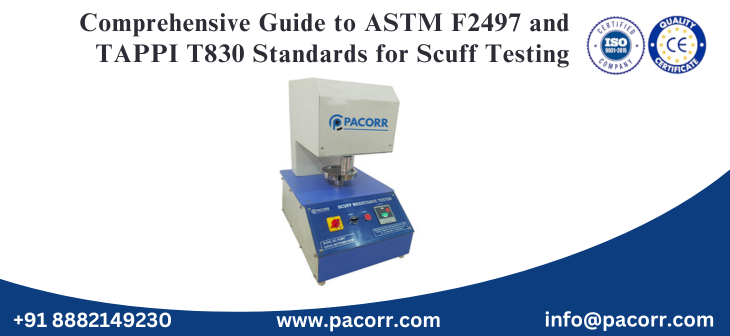
When it comes to packaging and print durability, Pacorr stands at the forefront, offering advanced testing instruments tailored for precise and reliable results. Among the many challenges faced in the packaging industry, scuff resistance has become increasingly significant as brands demand that their printed materials, cartons, labels, and flexible packaging not only look attractive but also withstand the rigors of handling, shipping, and shelf display. Understanding and implementing globally recognized standards like ASTM F2497 and TAPPI T830 for scuff testing is vital for achieving consistent quality and performance in these products. This blog explores these key standards, why they matter, and how Pacorr’s expertise ensures your products always meet the mark.
What is Scuff Testing and Why is It Important?
Scuff testing is a crucial process in the evaluation of printed and coated surfaces. It measures the resistance of packaging, labels, or other materials to abrasion, rubbing, or scratching. Everyday products, from food packaging to consumer electronics boxes, face various levels of scuffing during transportation, handling, and shelf life. A poor scuff resistance leads to faded designs, illegible text, and overall lower perceived value of the brand.
With increasing consumer expectations and strict regulations, packaging manufacturers must invest in scuff resistance testers and strictly adhere to standards like ASTM F2497 and TAPPI T830 to maintain market reputation and ensure customer satisfaction.
Overview of ASTM F2497 Standard for Scuff Testing
The ASTM F2497 standard is one of the most respected protocols in the industry for determining the scuff resistance of printed or coated surfaces. Developed by ASTM International, this standard outlines the procedures to simulate the effects of scuffing, rubbing, or abrasion under controlled conditions.
Key Features of ASTM F2497:
- Purpose: It is designed to evaluate the ability of packaging, labels, and printed surfaces to withstand scuffing and rubbing that occurs during normal handling and transportation.
- Test Procedure: The test involves rubbing two surfaces together—typically, a printed sample and a reference substrate—under a controlled load, speed, and time. The degree of damage or ink transfer is then visually assessed or measured using specialized equipment.
- Applications: ASTM F2497 is applicable to a wide range of packaging types, including folding cartons, flexible packaging, printed labels, and more.
- Result Interpretation: The results help manufacturers select appropriate coatings, inks, and finishes that enhance durability and maintain visual appeal throughout the supply chain.
Pacorr’s Scuff Resistance Tester is engineered to seamlessly comply with ASTM F2497, providing precise, repeatable, and standardized results that packaging professionals trust.
TAPPI T830: The Standard for Abrasion Resistance of Printed Materials
TAPPI (Technical Association of the Pulp and Paper Industry) is another globally recognized body setting industry benchmarks. The TAPPI T830 standard is specifically focused on evaluating the abrasion resistance, commonly known as scuff resistance, of printed surfaces on paper and paperboard.
Highlights of TAPPI T830:
- Scope: This standard outlines methods for assessing how well a printed or coated surface can resist rubbing or abrasion. It is particularly relevant for the paper, board, and packaging sectors.
- Testing Method: TAPPI T830 typically uses an abrasion tester where a printed sample is rubbed against a standard abrasive surface under fixed conditions. The test measures the extent of ink wear or surface damage, providing quantitative data for quality control.
- Benefits: Using the TAPPI T830 method, manufacturers can verify if their products will maintain print quality from production to the point-of-sale.
- Industry Adoption: The method is widely adopted by packaging converters, printers, and quality assurance teams for routine checks and R&D purposes.
Pacorr’s testing instruments are calibrated to deliver highly accurate results in line with the requirements of TAPPI T830, helping you meet the most demanding customer expectations.
Why Are ASTM F2497 and TAPPI T830 Critical for Packaging Quality?
Brand Protection and Consumer Trust:
Adhering to these standards is not just a technical requirement—it’s a promise to your customers. Packages and labels that resist scuffing project a higher-quality image, preserve important information, and reduce the risk of returns or complaints.
Compliance and Market Access:
Many large retailers and multinational brands mandate compliance with ASTM F2497 and TAPPI T830 in their procurement policies. Meeting these standards is often a prerequisite for entering new markets or supplying premium brands.
R&D and Product Improvement:
Continuous testing to these standards allows R&D teams to compare materials, coatings, or inks and make data-driven improvements, reducing costs while maximizing performance.
Step-by-Step Guide: How Pacorr Scuff Resistance Tester Works
- Sample Preparation:
Cut a standardized sample of the printed or coated material according to the test method specifications. - Mounting:
Place the sample securely on the test platform of the Pacorr Scuff Resistance Tester. An abrasive or reference surface is attached to the opposing side. - Setting Parameters:
Select the appropriate test parameters—load, speed, cycle count, and time—based on ASTM F2497 or TAPPI T830 guidelines. - Testing:
The tester automatically moves the surfaces against each other under controlled conditions, simulating the real-world scuffing scenario. - Assessment:
After testing, inspect the sample for ink removal, color fade, or surface abrasion. Quantitative analysis or visual grading may be performed as required. - Reporting:
Document the results and compare them against the target specifications or industry standards.
With Pacorr’s user-friendly interface, even non-technical personnel can conduct precise and reliable scuff tests.
Best Practices for Scuff Resistance Testing in Packaging
- Test Regularly: Incorporate scuff testing as part of your routine quality checks, especially when changing inks, coatings, or substrates.
- Benchmark Against Competitors: Use results to benchmark your packaging durability against industry leaders.
- Collaborate with Suppliers: Share test results with ink and coating suppliers to optimize formulations for better performance.
- Utilize Data for Process Improvement: Regular data collection helps in identifying trends, optimizing production, and reducing defects.
Pacorr: Your Partner in Quality Assurance
Pacorr’s commitment to quality and precision is reflected in every scuff resistance tester it produces. By supporting both ASTM F2497 and TAPPI T830 standards, Pacorr enables packaging manufacturers, converters, and brand owners to meet global quality benchmarks. The company’s focus on technical innovation, robust engineering, and after-sales support has earned it a reputation as a trusted partner in packaging quality control.
Key Product Keywords for Scuff Testing:
- Scuff Resistance Tester
- Abrasion Resistance Testing Machine
- Packaging Quality Control Instruments
- ASTM F2497 Scuff Testing Equipment
- TAPPI T830 Abrasion Tester
Frequently Asked Questions about ASTM F2497 and TAPPI T830 Standards for Scuff Testing
1. What is the main difference between ASTM F2497 and TAPPI T830?
ASTM F2497 is primarily used for flexible packaging and labels, while TAPPI T830 is focused on paper and board materials. Both set guidelines for scuff resistance but may differ in sample preparation and specific test conditions.
2. How often should scuff testing be performed in a packaging facility?
Scuff testing should be a part of every batch quality check, especially when there are changes in substrate, ink, or coating formulations.
3. Can Pacorr scuff resistance testers be used for both ASTM and TAPPI standards?
Yes, Pacorr designs its testers to accommodate a range of standards, including ASTM F2497 and TAPPI T830, making them versatile for various industries.
4. What are the common causes of scuff failure in packaging?
Improper ink adhesion, low-quality coatings, or insufficient curing processes are frequent reasons for poor scuff resistance.
5. How do scuff resistance results influence product development?
Results guide improvements in material selection and process parameters, ensuring long-lasting print quality and customer satisfaction.
Conclusion: Achieving Packaging Excellence with Pacorr and Industry Standards
ASTM F2497 and TAPPI T830 standards for scuff testing are essential for maintaining the visual and functional integrity of printed packaging in today’s competitive market. With Pacorr’s advanced testing solutions, packaging professionals can ensure that their products meet global durability standards, stand out on shelves, and build lasting brand value. By prioritizing regular scuff testing and compliance with recognized standards, companies safeguard both their reputation and bottom line—making Pacorr the partner of choice for packaging quality assurance.
Thanks to Pacorr Testing instruments, we have all the required quality testing instruments that have helped us to ensure the best quality delivered to our clients.

Danish
Fair Exports Pvt. Ltd.

